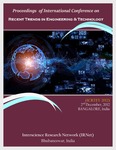

Published Date: 02-12-2012
Place of Conference: Bengaluru, India
Publisher: Institute for Project Management Pvt. Ltd.
DownloadProceeding of International Conference on Recent Trends in Engineering & Technology
ISBN 978-93-82208-41-9 Back
Editors
Prof. Srikanta Patnaik Mentor, IRNet India
About Conference
The new economic millennium is surprisingly rushing with Innovation and Technology. There is a sharper focus on deriving value from the widespread global integration in almost all spheres of social, economic, political and technological subsystems. In the quest of making this earth a better place to live we have to make a strong hold upon sustainable energy source. Sustainable energy sources include all renewable energy sources, such as hydroelectricity, solar energy, wind energy, wave power, geothermal energy, bio-energy, and tidal power. It usually also includes technologies designed to improve energy efficiency. Energy efficiency and renewable energy are said to be the twin pillars of sustainable energy. Renewable energy technologies are essential contributors to sustainable energy as they generally contribute to world energy security, reducing dependence on fossil fuel resources, and providing opportunities for mitigating greenhouse gases. Although the discipline like electrical engineering has narrated academic maturity in the last decades, but the limitations of the non renewable energy sources, turbulence and disturbances in the energy propagation cascades various insightfulness and stimulation in post classical electrical era. Evidence shows that there are phenomenal supplements in power generation and control after the introduction of Energy Management System (EMS) supported by Supervisory Control and Data Acquisition (SCADA). As there is increasing focus on strengthening the capacity of the power houses with the existing resources or constraints some new dimensions like FACTS, Optimal System Generation, High Voltage DC transmission system, Power Generation Control, Soft Computing, Compensation of transmission line, Protection scheme of generator, Loss calculation, economics of generation, fault analysis in power systems are emerging. Since the world is suffering with water, food, and energy crisis, energy consumption has social relevancy. Let me highlight some of the recent developments in Electronics discipline. The new integrated devices did not find a ready market. Users were concerned because the individual transistors, resistors, and other electronic circuit components could not be tested individually to ensure their reliability. Also, early integrated circuits were expensive, and they impinged on the turf that traditionally belonged to the circuit designers at the customer's company. Again, Bob Noyce made a seminal contribution. He offered to sell the complete circuits for less than the customer could purchase individual components to build them. (It was also significantly less than it was costing us to build them!) .This step opened the market and helped develop the manufacturing volumes necessary to reduce manufacturing costs to competitive levels. To this day the cost reductions resulting from economies of scale and newer high-density technology are passed on to the user—often before they are actually realized by the circuit manufacturer. As a result, we all know that the high-performance electronic gadget of today will be replaced with one of higher performance and lower cost tomorrow. The integrated circuit completely changed the economics of electronics. Initially we looked forward to the time when an individual transistor might sell for a dollar. Today that dollar can buy tens of millions of transistors as part of a complex circuit. This cost reduction has made the technology ubiquitous—nearly any application that processes information today can be done most economically electronically. No other technology that I can identify has undergone such a dramatic decrease in cost, let alone the improved performance that comes from making things smaller and smaller. The technology has advanced so fast that I am amazed we can design and manufacture the products in common use today. It is a classic case of lifting ourselves up by our bootstraps— only with today's increasingly powerful computers can we design tomorrow's chips.

